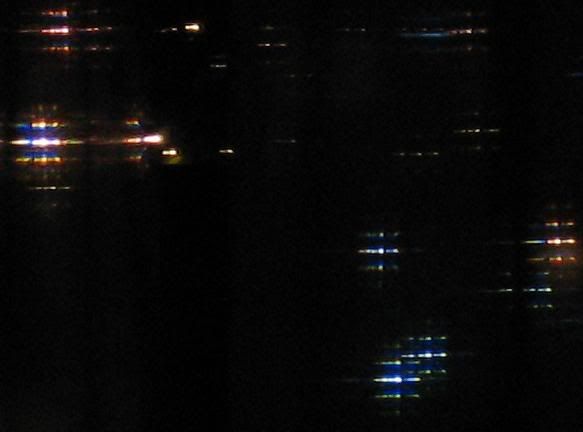Optical effect
Go into a room at night, with nets. Turn out all the lights and look at a distant light this is the effect you will see if you look closely.

Sadly I can not get a perfect picture, partly becuase I can not hold everything perfectly still. I can not afford an optical bench which is 100s of meters long. If anyone here has such an optical bench then please tell me.
_________________
Health is a state of physical, mental and social wellbeing and not merely the absence of disease or infirmity
 I am not a jigsaw, I am a free man !
I am not a jigsaw, I am a free man ! Diagnosed under the DSM5 rules with autism spectrum disorder, under DSM4 psychologist said would have been AS (299.80) but I suspect that I am somewhere between 299.80 and 299.00 (Autism) under DSM4.
I think you need to explain a little more. What did you use to take the picture? I am thinking your talking about some fance equipment to mesure light? Anyway to take a photo at night all you need to do is mount your camera to something solid and for a dSLR use a shuter release or set it for a timer. But if your doing this for some sort of experiment, you need to know that what your looking at can fool you, there are so many factors to consider, the opticle glass used on the lens, air polution, reflection within the lens, there are a endless number of factors that will cause a illusion.
If you explain it a little more then someone might know?
hmm..the spectral effect there can be from the lenses, though you'd think they have that fixed by now. There's filters you can put on an SLR, for example, that will do this.
Back in the Rennaisance, this was more of a problem with telescope lenses. They fixed it back then by using a combination of crown and flint glass.
this probably wasn't much help, but it did sorta remind me of it.

Sadly I can not get a perfect picture, partly becuase I can not hold everything perfectly still. I can not afford an optical bench which is 100s of meters long. If anyone here has such an optical bench then please tell me.
Nice saturated colors, kind of retroish, what camera is that?
_________________
One of God's own prototypes. Some kind of high powered mutant never even considered for mass production. Too weird to live, and too rare to die.
I used a compact cannon digital camera, I am sure that the effect is not a camera artefact as I can see the same effect with the naked eye and I have also photographed it with a different camera.
The nets are net curtains which act as a pair of diffraction gratings which are at 90 degrees to each other. I was using light from distant street lights and houses as the light source. If you use the standard A-level physics text books then you can get the equations for diffraction gratings.
d sin angle = m wavelength
is the equation which you need to use.
_________________
Health is a state of physical, mental and social wellbeing and not merely the absence of disease or infirmity
 I am not a jigsaw, I am a free man !
I am not a jigsaw, I am a free man ! Diagnosed under the DSM5 rules with autism spectrum disorder, under DSM4 psychologist said would have been AS (299.80) but I suspect that I am somewhere between 299.80 and 299.00 (Autism) under DSM4.
Set your camera for various exposure and focal lengths, put it on a stable surface, and experiment. You're clearly capturing light coming through your "diffraction grating", though it's likely that the net curtains form a grating that is far from perfectly regular.
Also, work with the captured images in RAW format if you have the software to do so. The JPEG compression process may alter subtleties in the image that would be useful for study.






